|
|
Post by chasensfo on Mar 23, 2022 22:50:39 GMT -5
I have some - if not all - JP from the late 1970s to mid 1990s, if there's any information needed. Also, didn't FAIB announce an update for the 737, which would include the series 100 aircraft? Kind regards. They did, but why not do this while we wait? |
|
|
|
Post by chasensfo on Mar 24, 2022 1:24:17 GMT -5
....a 90/91 JP Fleets book would come in handy. I have it. What do you like to know, Chasen? Werner It would help for Alaska, USAir and American 1989/90! Thanks! |
|
|
|
Post by sakura on Mar 24, 2022 11:02:32 GMT -5
Oh man us air 1990 would be a dream in 2020 and P3dv5
|
|
|
|
Post by noob21 on Mar 24, 2022 14:22:33 GMT -5
Anything with that old Burgundy livery.
|
|
|
|
Post by chasensfo on Mar 28, 2022 11:44:35 GMT -5
\\Air LA 1989 Air LA (1981-1991;1993-1995) IATA: UE ICAO: UED CALLSIGN: AIR LA Air LA (marketed as "AirLA") was a Californian commuter airline based in Los Angeles (LAX), which was a small carrier for most of its life but underwent a major expansion in its last year or so of operations. The carrier began life as an air taxi service based in Burbank (BUR) named Greater Pacific Airways, offering flights to Las Vegas (LAS) via the Grand Canyon (GCN) a Cessna 402C, and a Cessna 414. By 1984, the airline received the authority to operate scheduled flights, at which time it moved the operation to LAX and was rebranded as "AirLA". With just the 2 Cessnas, the carrier had to fight with local carriers Alpha Air and Stateswest over the commuter market with both carriers serving GCN and offering multi-stop services to Nevada via AirLA destinations. AirLA expanded to add flights along its routes to LAS to Laughlin, Arizona (IFP), a popular gambling location, and interestingly, Palm Desert (UUD) instead of nearby Palm Springs (PSP) which got virtually all of the airline traffic in that region. To better compete, AirLA added Jetstream 31s to its fleet in 1988, and the schedule was tweaked so that most cities were served as stops between LAX and LAS, with some routes also originating in Ontario (ONT), where a Piper Chieftan acquired to replace the Cessnas was based. The Southwest US network was expanded to Phoenix (PHX), and soon after in 1990, AirLA looked to serve Mexico. In an effort to obtain the authority to fly to Mexico, AirLA made the decision to buy Convair operator Air Resorts, who had the authority to operate commercial flights to Mexico, but AirLA had no interest in the Convairs or most of Air Resort's other assets. Though the merger, once completed in December of 1990, did grant AirLA the immediate ability to perform charter flights to Mexico, debt incurred from the merger forced the suspension of all operations for AirLA in early January of 1991 before these flights were ever operated. The Chieftain and Jetstreams were sold and the carrier became inactive, though it retained its operating certificate and international capability. USAir and Delta scaled back their West Coast commuter operations drastically, American wound down their San Jose (SJC) and San Francisco (SFO) American Eagle hubs thus ending many of their routes between NorCal and SoCal, and United Express eliminated most point-to-point flying outside of some multi-stop routes between SFO and LAX. Rival carrier Stateswest had become a USAir Express carrier and Alpha Air was operating on behalf of TWA Express, leaving the door open for AirLA to restart as the only independent commuter airline based in the Los Angeles area. The re-organized AirLA restarted in early 1993 with a pair of Metroliners wearing a new red, white, and blue livery alongside an EMB-110 from DirectAir, wearing the basic Midway Connection livery that aircraft had worn until Midway Airline's 1991 failure. A second EMB-110 was operated very briefly with a red fuselage stripe and tail until both Metroliners were active. The leisure and resort routes that were once the bread and butter of AirLA were dropped in favor of serving markets that recently lost significant commuter air service or now faced exorbitant fares due to a lack of competition. Still, rather than immediately resuming its role as a California commuter carrier, AirLA secured a codeshare with Aeromexico and instead re-launched services by first offering flights between LAX and Tiajuana (TIJ) operated by the Metroliners. In addition, the EMB-110 was used for on-demand charter work and some scenic tour flights. Within a few months, the EMB-110 was returned to its lessor and 3 additional Metroliners allowed for expansion to the Northern Californian cities of Stockton (SCK), which serves as a satellite airport for both the San Francisco and Sacramento areas, and Monterey (MRY) along with other cities such as Bakersfield (BFL) Fresno (FAT), and San Diego (SAN). By the Spring of 1993, AirLA added flights to the Mexican city of Ensenada (ESE), where AirLA was the first scheduled air carrier to serve that airport. International service quickly expanded to add Hermosillo (HMO), Mexicali (MXL), and San Felipe (SFH) to the route network. Service to LAS and PHX was resumed by 1994, at which time AirLA made the bold decision to purchase Minnesotan commuter carrier Capitol Air. Capitol Air was a small scheduled airline based in St. Paul, Minnesota at the St. Paul Downtown Airport (STP) which operated Metroliners on a single commuter route to Chicago Midway (MDW). Capitol Air was the first airline to attempt to draw traffic to STP in lieu of using the much larger Minneapolis Airport (MSP), as all carriers had done previously, in hopes that the proximity to downtown St. Paul and Minneapolis and hassle-free travel would appeal to business travelers who wish to spend less time traveling. The carrier had only operated for a few months before being purchased by AirLA for $6 million, after which time AirLA quickly added flights to Milwaukee (MKE), the 2nd largest business market from the Minneapolis area. AirLA announced it would exit the US West Coast market, where though it had little direct competition, operating and facility charges were very expensive, and the carrier would now be headquartered in St. Paul. Very soon after the merger was completed in the summer of 1995 and high-frequency service to MKE and MDW from STP became the entire AirLA network, losses mounted and the carrier looked for an exit strategy. AirLA decided to purchase Austin (AUS)-based Texas commuter carrier Conquest Airlines. Conquest Airlines had a fleet of 13 aircraft, utilizing both the Metroliner and Beech 1900C, and had recently ran into hard times after a period of expansion that saw it add several bases and a robust network between Texas and Southeastern US. Due to the struggles of Conquest Airlines, AirLA managed to acquire the airline for roughly $5 million, less than it paid for the much smaller Capitol Airways. Upon this acquisition, AirLA elected to cease its own operations and operate Conquest Airlines as a wholly-owned subsidiary. By late 1995, the STP-hub was closed and all AirLA aircraft were sold or returned to lessors. Conquest Airlines continued independent operations under AirLA's ownership until failing in late 1997. These plans represent AirLA in December of 1989 with Jetstreams and a Piper Chieftain. I think the Jetstream may have been painted as part of a package of assorted retro paints by an RAI member, but I can not locate it. I do not think the Piper, or even Cessnas to be used as a substitute, have been painted. I could not find any photos of the Piper, so I used the tail number of a Cessna for now. Jetstream 31: 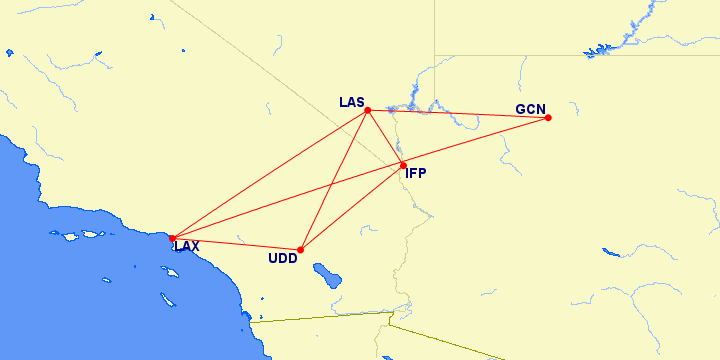 Piper Chieftain: 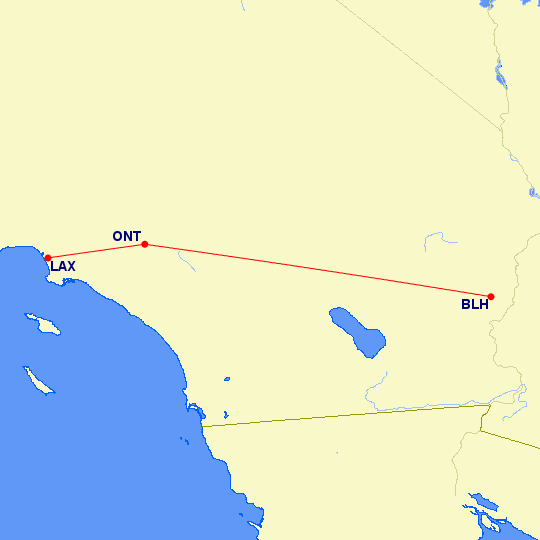 Download Air LA 1989 Flightplans Here Download Air LA 1989 Flightplans Here |
|
|
|
Post by chasensfo on Mar 28, 2022 13:37:39 GMT -5
\\Air LA 1995 v2 Air LA (1981-1991;1993-1995) IATA: UE ICAO: UED CALLSIGN: AIR LA These plans represent Air La at the end of its life in April of 1995, after the merger with St. Paul (STP)-based Capitol Air and just before West Coast operations ended in August of 1995. By this time, all cities in Mexico except for Hermosillo (HMO) and Tijuana (TIJ) had been dropped already, as had San Deigo (SAN) and Monterey (MRY). Air LA, though still based in Los Angeles (LAX), only had routes running North to Stockton (SCK) via Bakersfield (BFL) and Fresno (FAT) or down to TIJ remaining. The routes were more or less centered on connecting passengers in the Mexican communities of BFL and FAT with HMO and TIJ via LAX, Las Vegas (LAS), and Phoenix (PHX). LAX had a daily TIJ flight, while LAS had 2 and PHX had 2 daily flights to HMO. The STP operation is represented in its final form, with the lone STP to Chicago-Midway (MDW) route supplemented with the new Milwaukee (MKE) flights which included 2 daily MKE-MDW flights. All flights would end by the end of 1995 when Air LA bought Austin (AUS)-based Conquest Airlines and decided to end its own airline operations in favor of owning Conquest Airlines and letting it operate mostly independently. Only Metroliners were operated in this schedule. These plans were totally re-done, please discard the older plans from several years ago if you are using them. If you are using my 1994 Capitol Air plans in the same traffic install as these plans, I recommend that you delete them as most of the flights will be duplicates. I have painted the DJC Metroliner here: drive.google.com/drive/u/1/folders/1w6FY-9z9Bd1q9Ol0wf5xHCgNoIrv418xMetroliner III: 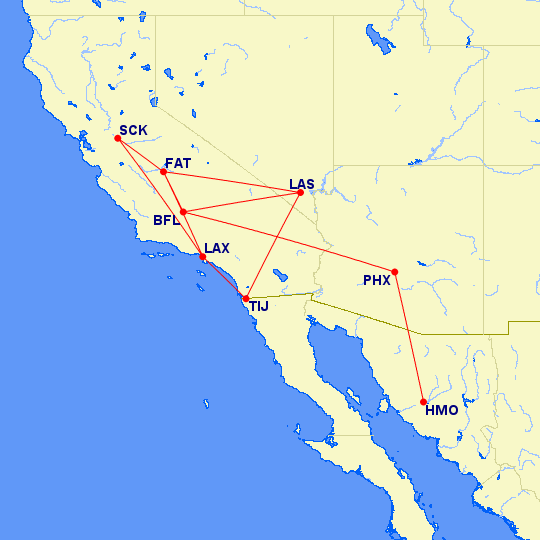 Metroliner III (ex-Capitol Air): 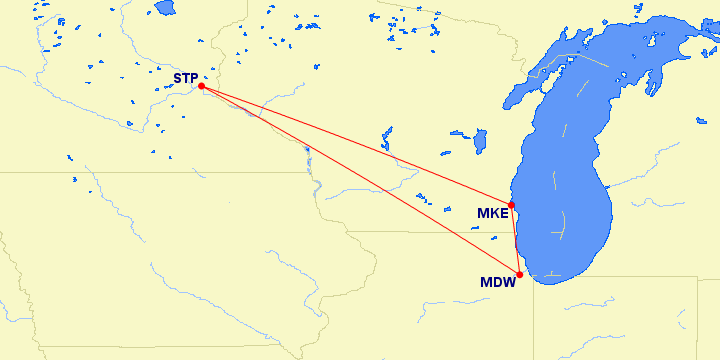 Download Air LA 1995 v2 Flightplans Here Download Air LA 1995 v2 Flightplans Here |
|
|
|
Post by chasensfo on Mar 28, 2022 14:17:37 GMT -5
\\Capitol Air 1994 Capitol Air operated by Empire Airlines (1993-1994) IATA: EM ICAO: CFS CALLSIGN: EMPIRE AIR Capitol Air was a short-lived Minneasotan commuter airline based at the St. Paul Downtown Airport (STP), with the carrier's name reflecting the carrier's home base of St. Paul, the capital of the State of Minnesota. Prior to the start-up of Capitol Air, STP did not have any regularly scheduled airline service and hadn't had scheduled passenger service in its history other than air taxi operation active from the late 1970s to the early 1980s by Lake State Airlines (later re-named "Midwest Aviation") offering $10 roundtrip fares to the nearby Minneapolis\St. Paul International Airport (MSP), which was used by all other carriers. Given the daily demand for business travel between the Minneapolis\St. Paul and the central location of STP on the Mississippi River adjacent to Downtown St. Paul and not far from downtown Minneapolis, the founders of Capitol Air figured there would be demand for high-frequency service to Chicago-Midway (MDW) for travelers who didn't wish to deal with getting to MSP and would rather just hop on and off the aircraft quickly in lieu of navigating a large hub airport. Empire Airlines, who was primarily a FedEx feeder operator at the time and had recently just concluded operating Fokker 27s for Hawaiian start-up Mahalo Air, was chosen to operate a pair of Metroliners on behalf of Capitol Air in Capitol Air's own colors. Flights began in late December of 1993 on the STP-MDW route. Very quickly, the tiny carrier was studied by established California commuter airliner Air LA, who was looking for an opportunity to relocate out of California to a part of the country offering lower taxes, usage fees, and operating costs. By mid-1994, Air LA had started the process of attempting to purchase Capitol Air, and service was expanded to Milwaukee (MKE), the second-largest business market from the Minneapolis area, including a twice-daily link between MKE and MDW. The carrier was sold to Air LA for $6 million and by the end of 1994, Empire's operations ended and Air LA began moving aircraft to STP from California, assuming Capitol Air's routes with its own aircraft by 1995. Though Air LA did relocate its headquarters to St. Paul and ended all West Coast flying in August of 1995, the Minnesota operation was unsuccessful for Air LA with losses mounting, in part due to a major flood that entirely submerged STP in 1995 damaging some aircraft and facilities. A decision was made to purchase Austin (AUS)-based Conquest Airlines and operate that carrier as an independent subsidiary while ending all Air LA operations by late 1995. STP has not had scheduled passenger service again since the shut-down of Air LA. These plans represent Capitol Air in its final form in late 1994 with MKE service. If you are using my 1995 Air LA plans, those plans represent Air LA AFTER this merger and thus contain duplicate flights. Delete the segregated STP-based Air LA flights to avoid duplicates if installing both airlines. I have painted the DJC Metroliner Here: drive.google.com/drive/u/1/folders/1S-2aaBpaXtK8oHOP-lupRWy8swpDz98TMetroliner III operated by Empire Airlines:  Download Capitol Air 1994 Flightplans Here Download Capitol Air 1994 Flightplans Here |
|
|
|
Post by chasensfo on Mar 28, 2022 15:27:37 GMT -5
\\Aspen Mountain Air 1996 Aspen Mountain Air (1996-1998) IATA: LD ICAO: LSS CALLSIGN: LONE STAR Aspen Mountain Air was the rebranding of established Texas Commuter carrier Lone Star Airlines, based in Ft. Worth (FTW), after the sale of that company to Peak International, which had previously had short-lived TriStar Airlines operated BAe-146 flights on an LAX-ASE-DEN route on its behalf. Lone Star Airlines itself began operations in 1984 Exec Express, first using Piper Navajos (and then 4 Dornier 228s starting in 1987) on commuter services in Texas and Oklahoma with the callsign "Hustler". Exec Express operated until 1988 when the carrier filed for bankruptcy protection and was subsequently shut down by the FAA on 09APR88 due to maintenance inadequacies. Just 2 months later in June of 1988, the carrier reorganized and re-started operations using Piper Navajos under the name "Exec Express II", with the company electing to not resume Dornier 228 operations. Once again, Exec Express II was flying Texas commuter routes centered on the Dallas\Ft. Worth area, especially out of DFW. The carrier quickly added larger Beech C99 Airliners and began a steady Eastward expansion adding destinations in the Southeast United States, and began adding 19-seat Metroliners (most of which were acquired from American Eagle carriers) as the backbone of the new fleet. The carrier changed its name to Lone Star Airlines in 1991 and changed the callsign to "Lone Star". The carrier adopted a white livery with the Texas state flag across the fuselage, and by 1994, an EMB-120 Brasilia and several large Dornier 328 turboprops were added to the fleet. A St. Louis (STL) focus city was opened and the carrier established a maintenance base in Hot Springs, Arkansas (HOT). The Dornier 328s were used both for longer domestic routes to destinations such as Denver (DEN) as well as for a 1993 international expansion into Mexico, with the carrier initially serving Saltillo (SLW), Hermosillo (HMO), Torreon (TRC), Chihuahua City (CUU) via El Paso (ELP). Routes to SLW and HMO were very low-yielding and were abandoned in a matter of months, while TRC and CUU flights continued for some time. In 1995, further, expansion was fueled by additional Dornier 328s joining the fleet bringing the total to 9 aircraft, alongside 19 Metroliners which made up the bulk of the fleet at the time. Flights were added as far from Texas as Knoxville, Tennessee (TYS) and Terra Haute, Indiana (HUF) while the carrier also sought FAA certification to begin serving Aspen (ASE). Being a busy and congested airport wrapped in a narrow valley in the Rocky Mountains, the FAA requires airlines wishing to provide scheduled flights to create an intensive training course for pilots to operate a series of trial flights until the FAA is satisfied with the carrier's ability to safely operate into ASE. As part of the certification process, Lone Star Airlines was offered to test and implement new technology from Lockheed Martin known as APALS (Autonomous Precision Approach Landing System). Lone Star Airlines completed certification both as the first carrier to use APALS and for performing ASE flights within a few months, allowing for the carrier to provide the first flights between DFW and ASE in 1996. At the time, ASE had limited air service, only being served by United Express (Air Wisconsin) with BAe 146 commuter flights to DEN. Around this same time, TriStar Airlines, a small Las Vegas (LAS)-based BAe 146 start-up carrier which had been providing flights to LAX and DEN from ASE on behalf of Peak International, had gone bankrupt at shut down. Seeing the certification of a new air carrier at ASE as an opportunity, Peak International purchased Lone Star Airlines in 1996. Immediately, Peak International created a subsidiary of Lone Star Airlines called "Aspen Mountain Air", adopting a new livery featuring colors on the tail representing a mountainous scene for the Dornier 328 fleet as aircraft were gradually transferred over from the Lone Star Airlines operation. Aspen Mountain Air flights began in late 1996 with aircraft flying DFW-ASE-DEN and back several times per day. Initially, only a few aircraft wore the new colors, and aircraft in the Lone Star Airlines livery commonly operated Aspen Mountain Air flights. By the end of the summer of 1997, all the Dornier 328s were either in the Aspen Mountain Air colors or had been sold to other carriers such as Mountain Air Express (MAX). With plenty of gate space available on Concourse C at the new Denver Airport, DEN was turned into a focus city with the carrier adding flights to destinations in Iowa and Montana while the network in the Southwest USA grew to include various points in New Mexico, Oklahoma, Arkansas, and Texas. American Airlines signed a codeshare agreement with Aspen Mountain Air, who began operating from American's gates in DFW. Lone Star Airline's own Metroliner flights were excluded from this codeshare. In April of 1998, the Lone Star Airlines branding and operation were abandoned. A few months later on 07AUG98, the carrier filed for bankruptcy protection. Flights carrier continued operating as Aspen Moutain Air until October when the airline shut down after facing additional competition in ASE since 1997 with both United Express and MAX (on behalf of Western Pacific Airlines) operating frequent flights to DEN for connecting pax onward in addition to new Northwest Airlink service to Northwest's Minneapolis (MSP) hub. Some of the Metroliners were operated well into the 2000s by fly-by-night cargo operators in the full colors of Lone Star Airlines. These 1996 plans represent Aspen Mountain Air early in its life when Lone Star Airlines was still operating alongside it, but they do not include Lone Star Airlines. Though the aircraft were quickly painted, you may realistically assign some aircraft to the Lone Star Airlines livery if you wish. I have painted the Aspen Mountain Air JBAI Do328 here: drive.google.com/drive/u/1/folders/1Atod_67opiWLf5qi1S1DTl39-KCRp9OVLone Star Airlines JBAI Do328: library.avsim.net/search.php?SearchTerm=brw_d328_lonestarairlines.zip&CatID=root&Go=SearchDornier 328:  Download Aspen Mountain Air 1996 Flightplans Here Download Aspen Mountain Air 1996 Flightplans Here |
|
|
|
Post by chasensfo on Mar 28, 2022 16:27:58 GMT -5
\\California Air Shuttle 1990 v2 California Air Shuttle (1990) IATA: 7Q ICAO: CSL CALLSIGN: CAL SHUTTLE California Air Shuttle was a short-lived California commuter airline based in Oxnard (OXR), near Santa Barbara (SBA). California Air Shuttle was founded from the ashes of Long Beach (LGB)-based commuter carrier Qwest Air, after founders Steven Lay and Michael Minson from that carrier attempted to provide non-stop service with decent frequencies to the community of OXR. Suck in the shadow of the more popular destination of SBA, OXR was steadily losing service in the late 1980s, with only American Eagle serving the airport by 1990 via Los Angeles (LAX). Seeing the potential for non-stop service between OXR and Northern California as an open market, 2 Metroliner IIIs were acquired in late 1989 and painted in a bold, eye-catching livery with a tan top side, blue belly, and white and red stripes. Service began in January 1990 with flights to Las Vegas (LAS), but within a few weeks, service was expanded to Sacramento (SMF), San Francisco (SFO), and San Jose (SJC). Before operations began, a codeshare agreement had been reached with America West, who, in turn, would be able to connect pax on and off of California Air Shuttle's flights to all 4 airports that were served from OXR. At some point in 1990, a 3rd Metroliner was operated to fulfill the schedule (which was created for 3 planes) after plans to acquire additional aircraft (including Beech 1900s) fell through, but it is unclear if this aircraft was leased and what livery it wore. By the summer of 1990, the airline began to cut flights and reverted back to its original OXR-LAS route as the carrier fell behind on fees owed to the Bay Area airports (which had already initially denied the carriers landing rights to begin with). Still, the CEO insisted that the carrier wished to expand to offer similar services to the small coastal city of Santa Maria (SMX), add Southern California cities like Orange County (SNA), and also hoped to expand on routes across the Southwest US as far away as Tucson (TUS). To achieve this, the company made a public stock offering in July of 1990 with hopes of raising $5 million in immediate funds for securing new aircraft leases and hiring and training more pilots. Unfortunately, the timing of this decision coincided with the start of the Gulf War which brought forward skyrocketing oil prices and dwindling travel demand. Before the airline was able to add additional aircraft, it went bankrupt in December of 1990 and was forced to cease all operations and return both its aircraft to the lessors. American Eagle pulled out of OXR soon after, but United Express returned a few years later with flights to LAX operated by SkyWest Airlines for about 2 decades until the carrier retired its EMB-120s and decided the airport was not suitable for CRJ operations in 2015. Since then, OXR has not had any scheduled airline service. I have totally re-done the flightplans, so please discard the old ones if you are using them. I had to guess on a tail number for whatever 3rd aircraft preformed this schedule, which is included in the Google Drive files. I have painted the DJC Metroliner III here (and I have just updated the livery thanks to better, more modern sources for the colors as I first made this in 2008): drive.google.com/drive/u/1/folders/112fz99pjGECLBynEirl9sOSia5LcvsgqMetroliner III:  Download California Air Shuttle 1990 v2 Flightplans Here Download California Air Shuttle 1990 v2 Flightplans Here |
|
|
|
Post by chasensfo on Mar 28, 2022 22:11:11 GMT -5
\\Stateswest Airlines 1989 Stateswest Airlines (1986-1993) IATA: YW ICAO: SWJ CALLSIGN: STATESWEST Stateswest Airlines was a short-lived US commuter airline based in Laughlin\Bullhead City, Arizona (IFP) with route networks in both California and Arizona. The carrier started operations in 1986 with Beech 1900Cs, Shorts SD3-60s, and a pair of Jetstreams, initially focused on connecting smaller cities only served by commuter carriers with no major airline service with large hubs like Phoenix (PHX), San Deigo (SAN), and Los Angeles (LAX). Most of Stateswest's routes passed through both IFP, which is a popular gambling destination, and nearby Lake Havasu (HII), which at the time was a much more popular leisure destination than it is today. Stateswest quickly added most of the LA Area major airports expanding to Burbank (BUR) and Orange County (SNA), and also connected both Tucson (TUS) and Sierra Vista (FHU) in Southern Arizona to the California network on multi-stop routes. By early 1988, the Jetstreas and the larger Shorts SD 3-60s were retired and Stateswest went to an all Beech 1900C fleet for a short time. Stateswest was the largest of the late 1980s Southern California commuter carriers for most of its life, competing mostly with Air LA and Alpha Air, both of which operated a handful of turboprops at the time, mostly out of LAX. Air LA shut down due to bankruptcy in 1988, and Alpha Air began operating on behalf of TWA Express and MGM Grand Air from LAX. The Arizona network was mostly in direct competition with Mesa Airlines and America West Airlines. In 1990, after USAir decided to dismantle most of the ex-PSA routes it picked up in the 1988 merger between the 2 carriers by slashing routes or downsizing them from 737s, MD-80s, and BAe 146s to commuter aircraft. For this task, USAir selected Stateswest as the West Coast USAir Express carrier. With operations centered on the former PSA hubs of San Diego (SAN), San Francisco (SFO), and LAX, the Stateswest B1900C fleet began to appear in the full USAir Express colors quickly by mid-1990, with the small touch of a "PSA smile" painted on the nose of the aircraft as a nod to the acquired carrier whos routes were being flown by these commuter aircraft. As Stateswest began operating for USAir, the mainline flights were quickly pulled from the US West Coast except for a few key routes which continued into the mid-1990s and flights to the East Coast USAir hubs. Cities retained in the USAir network included Stockton (SCK), Monterey (MRY), and Concord (CCR), where USAir Express (and PSA before it) was the only air carrier. Smaller Beech B200 King Airs were acquired and put to use as commuter airliners, followed by a lone Metroliner in 1991. With plans for a modern expansion, USAir ordered 3 DHC-8s for Stateswest which arrived in late 1992, but it is unclear if they were put into service as there don't seem to be any photos of them operational in the route network. By 1993, USAir made a decision to do a second large round of cuts to the West Coast network. It was decided that instead of 34-seat DHC-8s, Trans States Airlines (who primarily flew for TWA Express out of STL and JFK) would operate 19-seat Jetstream 32s on behalf of USAir and the California commuter network would be entirely slashed except for Sacramento (SMF), Monterey (MRY), San Diego (SAN), Fresno (FAT), Palm Springs (PSP), and Ontario (ONT), which were connected to SFO and\or LAX. The Jetstreams would be operated in Trans States own colors, with a red and dark blue stripe similar to those found on mainline USAir planes, and the flights would also codeshare with Alaska Airlines and Northwest Airlines. By late 1993, Trans State's Jetstreams replaced Stateswest, which folded rather than finding new business. Many of the destinations served by Stateswest, such as HII and FHU, have not had true airline service in the last few decades. These flightplans represent Stateswest at its largest independent size, shortly before becoming a USAir Express carrier. I have a repaint for the HTAI B1900C, but I am not sure where I got it, I think another assorted commuter package from an RAI member. Any help finding it is appreciated. Beech 1900C: 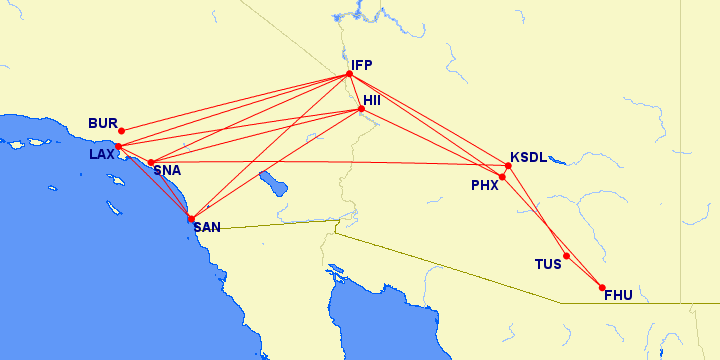 Download Stateswest Airlines 1989 Flightplans Here Download Stateswest Airlines 1989 Flightplans Here |
|
|
|
Post by chasensfo on Apr 2, 2022 15:35:35 GMT -5
Installed what 727-100 textures I didn't have from cgold's Google Drive, and then realized a lot of these birds had no plans, so, I made some. \\Spirit of America Airlines 1985 Spirit of America Airlines (1959-1989) IATA: IM (formerly 2J) ICAO: IAS CALLSIGN: BOXHAULER Five Star Airlines (operated by Spirit of America Airlines) (1985-1986) IATA: IM (formerly 2J) ICAO: FFQ CALLSIGN: FIVE STAR Winky's Fish Airlines - WFA operated by Spirit of America Airlines (1985-1989) IATA: IM (formerly 2J) ICAO: IAS (you may also use WFA for parking) CALLSIGN: BOXHAULER Spirit of America Airlines was a US ACIM (Aircraft, Crew, Insurance, Maintenance) firm based in Burlingame, California near San Francisco (SFO) which, in the final years of its life, briefly operated some aircraft independently. Founded in 1959 as IASCO, the carrier initially provided taxi and on-demand cargo charter services with small props and jets. However, most of IASCO's business was not flying freight but providing crews to foreign airlines, leasing out aircraft, and later, providing flight training for Japan Air Lines (JAL) prospective pilots in Napa, California, on the North end of San Francisco Bay. As air cargo grew more popular in the US, IASCO began formally operating 4 Dassault Falcon 20Cs and some Cessna Citations and Titans on behalf of Emery Express starting in 1976. Soon after, the company began operating Learjets on behalf of Canadian carrier Purolator Courier, operating a route between Los Angels (LAX) and Columbus, Ohio (CMH). In the early 1980s, IASCO applied for the authority to operate scheduled passenger and cargo services, and the carrier began operating a 737-200 for Purolator. In 1983, the authority to operate scheduled services was granted and the carrier quickly added a large fleet of 727s to fly on behalf of Emery Worldwide of Dayton, Ohio (DAY) and Burlington Air Express of Toldeo, Oh (TOL), neither of which had the authority to operate their own planes at the time. Aircraft were operated both long and short term on behalf of over 1 dozen other customers as well. In 1985, the airline changed it's name to "Spirit of America Airlines", and began operating its own flights with an LAX base painting at least 1 727-100 and 1 Lockheed L-188 Electra into its own colors, presumably for sub-service and on-demand cargo charters. A DC-8-73CF was acquired from Transamerica Airlines as a converted freighter and put on a route to New York (JFK) from LAX via ORD, still in full Transamerica colors with plugged windows and "Spirit of America" titles. The DC-8-73CF operation only lasted a few months, and evidence suggests that Spirit of America's own flights ended by the end of 1986. 1985 start-up carrier Five Star Airlines, unable to operate its own aircraft, chose Spirit of America to operate the 2 L-1011-1 Tristars it had leased from TWA in their basic livery to operate inclusive tour charters during the winter for GWV Travel's all-inclusive tours. The aircraft operated to various warm-weather destinations in the US, Mexico, and the Caribbean primarily from the Northeastern United States with the main bases being Boston (BOS) and JFK. At the same time, the carrier was also flying a 727-100 in the basic colors of Emery Worldwide with "WFA" titles on behalf of Winky's Fish Airlines in Alaska. Winky's Fish Airlines flew on behalf of a large fishery, called William “Winky” Crawfords Northern Peninsula Fisheries Corporation, which provided fresh Alaskan salmon to the rest of the world via large Alaskan port cities like Anchorage (ANC), Fairbanks (FAI), and Juneau (JNU) as well as Seattle (SEA), with the shipments usually coming from Kenai (ENA) and Prudhoe Bay\Deadhorse (SCC). Five Star's business model involved leasing 2 TWA L-1011s during TWA's down season each winter, and seasonally suspending flights and returning the aircraft during the high travel season. After the 1986 season, Five Star was able to operate the L-1011s itself, and Spirit of America's contract ended. Five Star flew on until international charter expansion to try and attract more business lead to heavy losses and the company failed, at which time American Trans Air (ATA) took over GMV Travel's flying. A major move was made in 1986 when Cam Air International, a Miami (MIA)-based cargo operator, was purchased. Rather than merging the airlines, Spirit of America left Cam Air International to operate independently but did transfer some assets over from time to time. Spirit of America gained another passenger contract in 1987, when it began operating for the well-known Casino Express Airlines, flying an ex-Midway Airlines 737-200 on behalf of the Red Lion Inn in Laughlin, Nevada (IFP). The gambling charters operated all across the country, serving both major airports and general aviation airfields alike, bringing in gamblers to IFP for all-inclusive packages. In 1989, the Spirt of America fleet consisted of about 50 aircraft and over 30 Boeing 727s, however, once BAX and Emery Worldwide obtained permission to operate their own aircraft, Spirit of America lost most of its business in a short period of time. With no work for much of the large fleet, Spirit of America went bankrupt in June of 1989 and all flights ended. The "Casino Express" branded flights continued with the lone 737-200 being transferred to a small carrier called TEM Enterprises. That carrier would be re-named "Casino Express", the 737-200 and 2 others would receive new bold and colorful liveries based on playing cards, and the airline itself would grow into Xtra Airways and then a 2021-launched Ultra-Low-Cost-Carrier (ULCC) known as Avelo Air. For some of the aircraft, I was able to get an accurate picture of the routes flown. For Spirit of America's own aircraft, I based the routes on photo evidence, and given the fact that I was able to find less than 5 photos of this brief operation on the internet and very little about the company's cargo own activities, I figure they flew by night and likely sat at rarely photographed locations outside of the few known ones. So those are representative. The Five Star plans will be good for 1986 also, the WFA plans will be good for at least 1985-1989. I will make plans for the Casino Express 737-200 if someone paints that original livery. Scheduled cargo services for Emery Worldwide, BAX Global, and other larger carriers are not included. Most cargo aircraft fly seldom during the weekend and have long ground times. The Five Star aircraft rarely did more than one round trip in a day. Christian Gold has painted the 727s and the L-188 Electra. The Five Star L-1011 and the Transamerica hybrid DC-8-73F are needed, but can easily be adapted onto HJG liveries but I'm not allowed to share those at the moment. One day, I will be able to release all my personal HJG repaints, I hope! But like the AIM DC-10s, it is currently a violation of their user agreement. AIA 727-100: drive.google.com/file/d/1pOeKY40bDDD5FOVKYxPQ-cJe-Mh2DD_U/view?usp=sharingCPAI L-188 Electra: drive.google.com/file/d/1794o3EIqmqAQ8TvSG3cy0x4ULUlOCBaI/view?usp=sharingL-1011-1 Five Star Airlines:  DC-8-73CF: 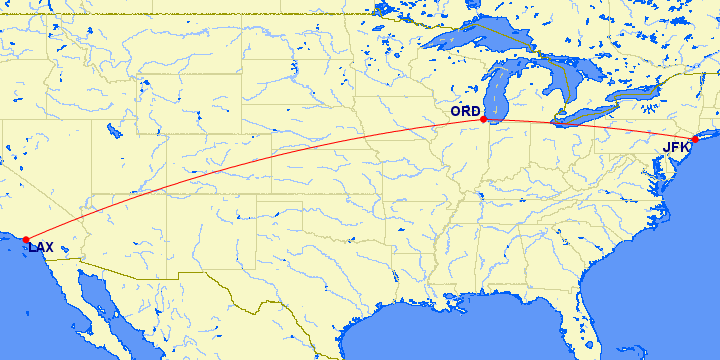 727-100F 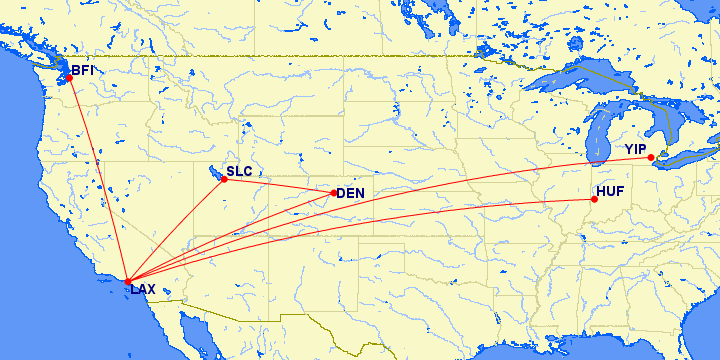 727-100F Winky's Fish Airline -WFA: 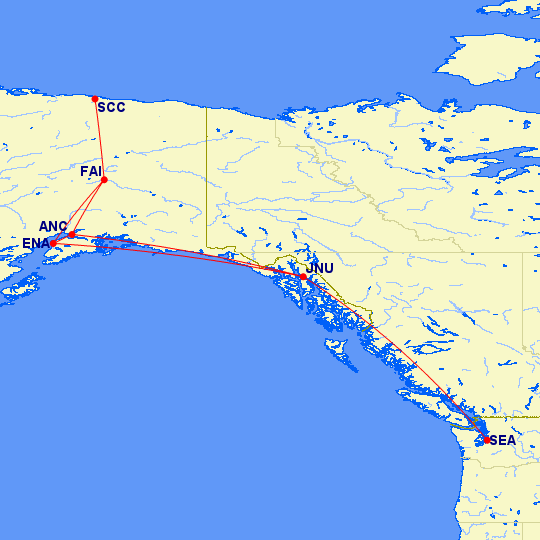 L-188F Electra:  Download Spirit of America Airlines 1985 Flightplans Here Download Spirit of America Airlines 1985 Flightplans Here |
|
|
|
Post by sakura on Apr 2, 2022 15:39:16 GMT -5
Winky's fish airline is the best name for an Airline ever.
|
|
|
|
Post by chasensfo on Apr 2, 2022 16:07:28 GMT -5
\\Patriot Airlines 1994 Patriot Airlines (1992-1994) IATA: P7 ICAO: PAA CALLSIGN: PATRIOT AIR DHL (operated by Patriot Airlines) (1992-1994) IATA: P7 ICAO: DHL CALLSIGN: PATRIOT AIR Emery Worldwide (operated by Patriot Airlines) (1992-1994) IATA: P7 ICAO: EWW CALLSIGN: PATRIOT AIR Patriot Airlines was a short-lived US cargo airline, headquartered in San Jose, California (SJC), which operated 2 ex-FedEx Boeing 727-100Fs on supplemental cargo flights for various US cargo airlines. The carrier was founded in 1991 by Andrew Barnes, who was both the former CEO of Air Train, the predecessor to Emery Worldwide, and a former airline pilot. Initially, Barnes planned to operate the carrier as an ACMI (Aircraft, Crew, Insurance, and Maintenance) operator, providing "wet leases" to companies as needed. However, the plan changed to operating cargo sub-services, likely due to Barnes' contacts in the industry, and a request was submitted for the authority to haul scheduled air cargo. Patriot Airlines received authority to begin operating scheduled cargo services in 1992, and flights were operated on behalf of various carriers including Airborne Express, Emery Worldwide, and DHL, with the aircraft having no set operational base and under the "PAA" ICAO code of recently failed Pan American Airlines. In 1993, the airline applied to operate scheduled passenger flights, but as the airline ran into trouble in late 1994, the airline withdrew its application in October before such flights were permitted. The carrier ceased operations on 02DEC94, having never grown larger than the 2 Boeing 727-100s it started with. The PAA code was then acquired by Carnival Airlines, which then changed its name to "Pan Am". There are very, very few photos of this airline operating and not stored. However, luckily one of them was taken by my friend Mark Durbin in SJC. He recalled seeing these planes at SJC was just as uncommon as seeing any other random supplemental cargo airline fill in, so there was not SJC hub operationally for the carrier. I chose to assign one 727 to DHL routes out of Cincinnati (CVG) and one to Emery Worldwide Routes out of Dayton (DAY). The aircraft arrive in the early morning usually and leave at night as they did in real life, with all routes real but representative. Maintenace was done in Opa Locka Florida (OPF) near Miami, so I have the planes spend the weekend there, as it was one of the only places they ever regularly sat together and the carrier likely rarely flew on weekends outside the holiday season. These plans are fine to represent the whole life of the airline. Christian Gold has painted both AIA 727-100s here: drive.google.com/file/d/1fmv1uMgmlbCHijfF2sBcOGPTDLT5uwK3/view?usp=sharing727-100F DHL: 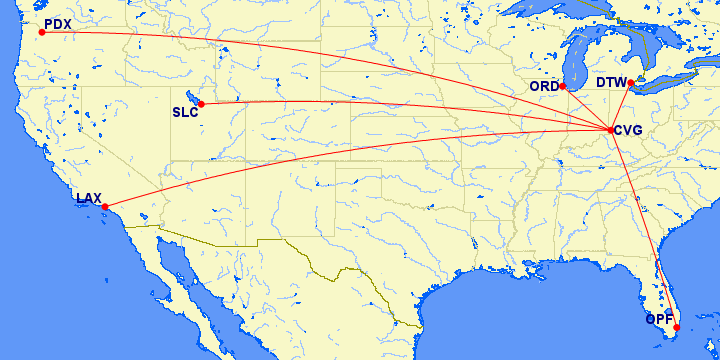 727-100 Emery Worldwide:  Download Patriot Airlines 1994 Flightplans Here Download Patriot Airlines 1994 Flightplans Here |
|
|
|
Post by chasensfo on Apr 2, 2022 16:09:21 GMT -5
Winky's fish airline is the best name for an Airline ever. Toats. I lol'd at it, had to look it up. It actually operated since the 1950s! Had Constellations for most of its life. I think it lived on past Spirit of America failing until sometime in 1990. |
|
|
|
Post by chasensfo on Apr 2, 2022 17:27:42 GMT -5
Since there are early 2000s and I think 90s Alaska Cargo plans floating around, just assign some 737-200C plans to the 727-100C texture used for these plans to have the Alaska Air Cargo 727 active in your 1991-94 AI traffic. \\ARCO Flight Operations 1985 ARCO Flight Operations (c. 1977-2000) IATA: NONE LISTED ICAO: NRS CALLSIGN: NORTH SLOPE ARCO Flight Operations operated by Alaska Airlines (c. 1985-1991) IATA: AS ICAO: ASA (you may also use "NRS") CALLSIGN: ALASKA ARCO Flight Operations was the airline responsible for the corporate transport of ARCO (Atlantic Richfield Oil) employees to and from Prudhoe Bay Oil Field, the gasoline giant's largest oilfield located in Alaska's "North Slopes" near Prudhoe Bay\Deadhorse, Alaska (SCC). The department started sometime around or slightly before 1977, initially with corporate aircraft such as the Sabreliner for executive transport a single Boeing 707-130B which operated the daily shuttle flights between ANC and SCC. ANC is where many of ARCO's employees working at the refinery in SCC lived or commuted home from by connecting to airline flights. From sometime around 1985, Alaska Airlines began operating a 727-100C on behalf of ARCO's shuttle service, which was painted in the full ARCO livery, though using the "Alaska" callsign and spending downtime in Seattle (SEA) where Alaska performed maintenance. There is evidence suggesting that the 707 made some trips to Vancouver (YVR) as well, seemingly for inspections and repairs. In 1987, the 707-130B was transferred to a company named Coastal SGC, but it is unknown if it continued in the corporate shuttle role with the new owner or if it was redeployed elsewhere. In 1989, the aircraft was sold to leasing agency Skyways International and began new activities, so the 707 flying concluded sometime between 1987 and 1989. The 727-100C, however, continued in the shuttle role until the early 1990s, with the aircraft rejoining the Alaska Airlines fleet under the Alaska Air Cargo banner as a converted freighter sometime around 1991. ARCO's full colors were retained on the 727-100, which operated for Alaska between 1991 and 1994 before being sold to cargo start-up Omni Air Express (the predecessor to Omni Air International) for just a few months before being sold again to a cargo start-up named Ting Tai International Corporation. Though there are photos of the 727 being converted for that carrier in Tucson (TUS) wearing its full livery, there was little information about that airline beyond the fact it was a logistics company headquartered in Foster City, California near San Francisco (SFO), but didn't serve SFO and failed long ago. After the 1991 end of the Alaska 727 flights, there is little information on the shuttle operation until at least 1999 when a 737-200 in the ARCO livery was documented operating the service, so it is possible that the service lapsed or another aircraft type was operated. The last photos of the 737 were taken in 2000 with no further evidence of operation. These plans are representative but should be accurate other than the flight times and numbers for the most part. The 727-100C spends the weekend in SEA for maintenance and the 707 does the same in YVR. Christian Gold has painted the AIA 727-100 here, but with the 1993 "Alaska Air Cargo" sticker on the #2 engine. I have made the modification to backdate it to pre-1991. The 707-130B is needed. Be sure to assign the cargo 727 a new entry using "GATE" parking. Photo evidence suggests that the aircraft used passenger gates and not apron parking. The AIA 727-100 as it appeared in the 1980s may be found here: drive.google.com/drive/u/1/folders/1XhyYXXVEh6I191k0sqNIYArJBaQYwTvZYou may download the original 727 with the Alaska sticker here: drive.google.com/file/d/1KpPNInuBcDJPqMTcOIQrPW2adraLV3Dp/view?usp=sharing707-130B: 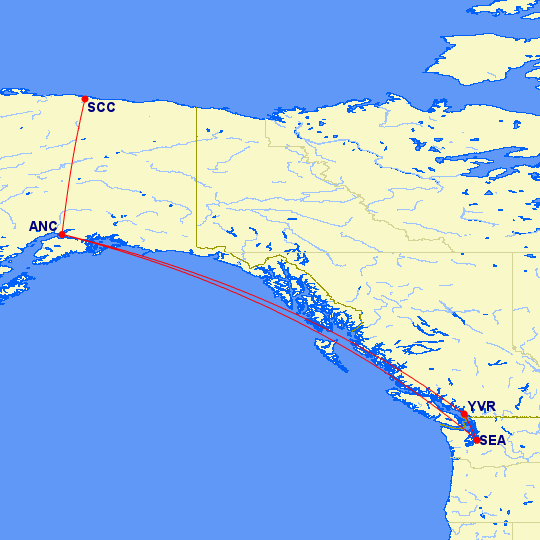 727-100C operated by Alaska:  Download ARCO Flight Operations 1985 Flightplans Here Download ARCO Flight Operations 1985 Flightplans Here |
|